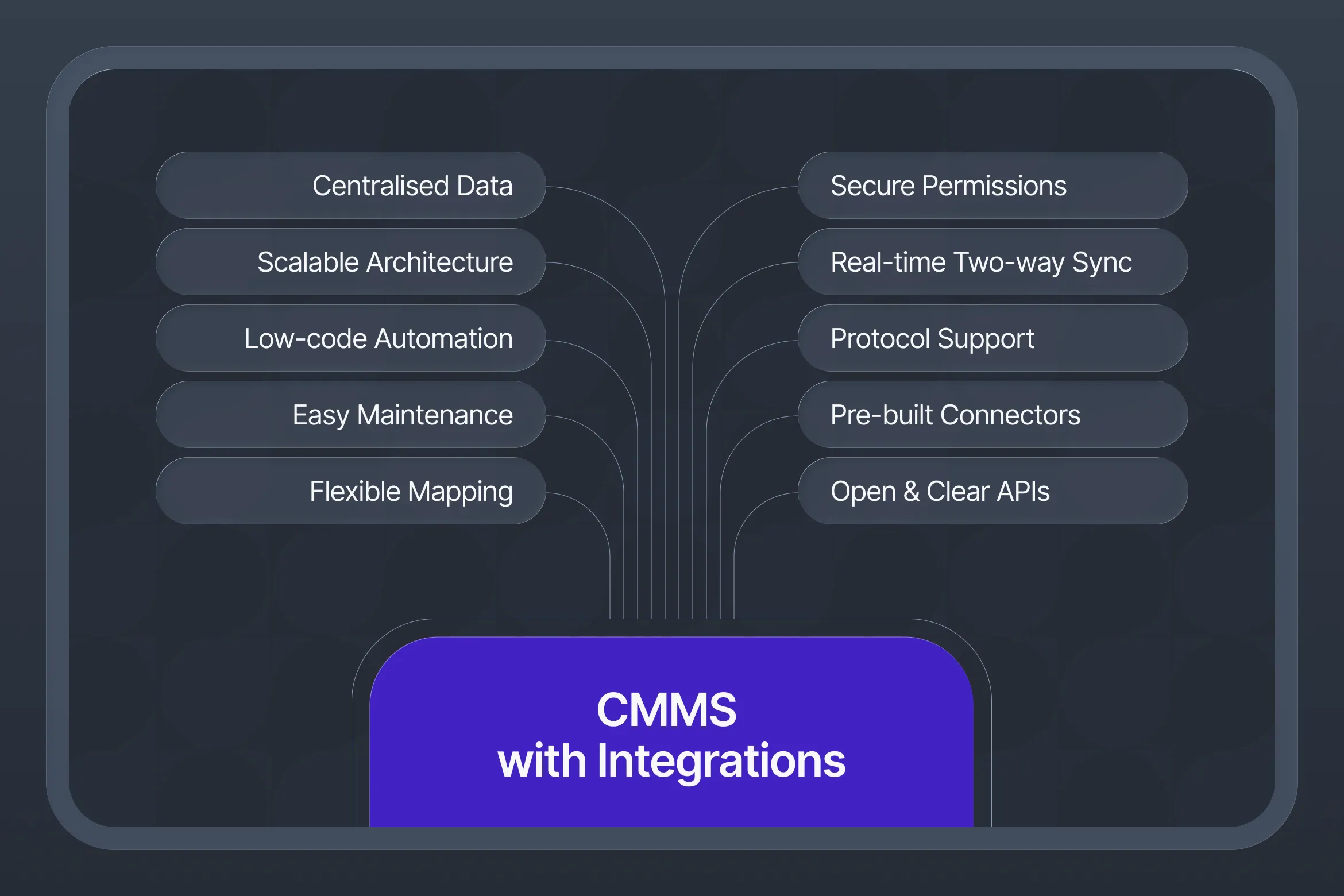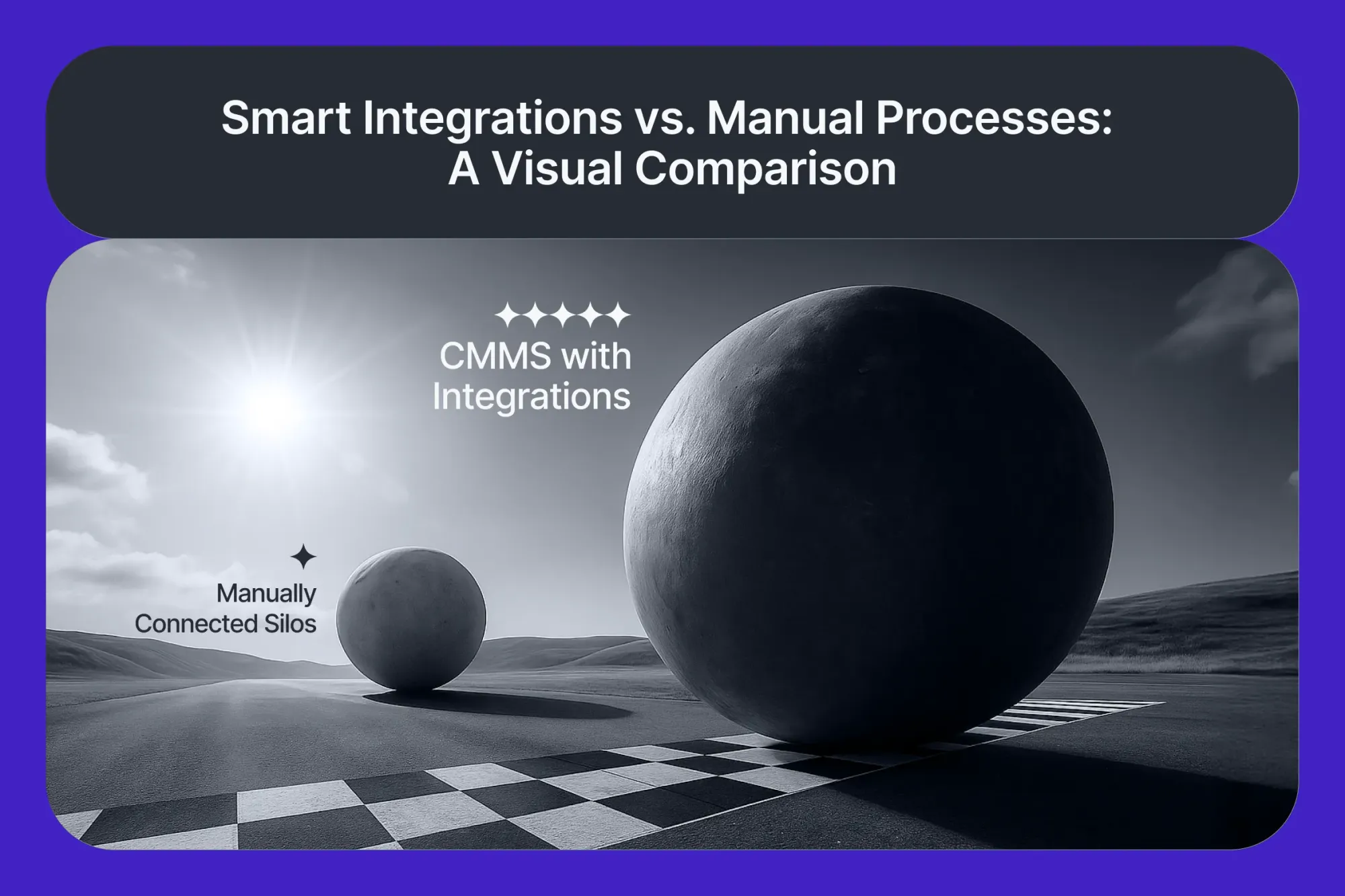Think of your CMMS as your facility’s central nervous system. Without proper integrations, it’s a brain that can’t communicate with limbs
By connecting its CMMS with the ERP and BMS, the system now auto-triggers procurement and escalations, cutting downtime and risk.
Table of Contents
- Why CMMS Integration Matters
- Types of CMMS Integrations (and Practical Use Cases)
- What Makes a CMMS Truly Integration-Ready?
- How Smart Integrations Improve FM
- Overcoming Challenges in CMMS Integration
- Facilio: One Platform, Limitless Integration
Why CMMS Integration Matters
Buildings now rely on many systems: asset management, maintenance, compliance, energy, procurement, and more. Each uses different digital tools like ERP, IoT sensors, Building Maintenance System, vendor platforms, and finance systems.
CMMS(Computerized Maintenance Management System) was built to unify these, but most legacy CMMS are closed or offer only basic integration. This causes duplicate work, slow fixes, bad data, and lower asset reliability.
Whereas an integrated CMMS :
- Eliminates data silos by syncing work orders, assets, and procurement data automatically.
- Provides real-time visibility into asset health and budgets.
- Automates workflows: auto-assigns work, auto-generates purchase orders, tracks compliance.
- Improves resilience by reducing downtime, costs, and risk.
- Boosts collaboration among maintenance, procurement, finance, and vendors.
But what types of integrations are available and what exactly do you get from it?
Types of CMMS Integrations (with Outcome-Driven Examples)
A modern, integration-ready CMMS connects with:

For a practical list of must-have integrations, see our guide: Top 5 CMMS Integrations Every Facility Manager Needs in 2025
What Makes a CMMS Truly Integration-Ready?

A truly integration-ready CMMS is designed for sustainable, secure, seamless connectivity. Look for:
- Open, clear APIs: Support REST, GraphQL, and protocols like BACnet, OPC, MQTT. This future-proofs your system and avoids vendor lock-in.
- Pre-built connectors: Instant links to major ERPs, BMS, and IoT platforms.
- Low-code/no-code automation: It lets non-IT staff build automation workflows easily.
- Centralised, normalised data: Unifies asset, compliance, and sustainability data for reporting and analytics.
- Real-time, two-way sync: Immediate updates across all systems, no batch delays.
- Security and permissions: Role-based access and encryption, critical when vendors and stakeholders share data.
- Scalable architecture: Supports growing assets, vendors, and geographies without costly rework.
- Protocol support: BACnet for controls, OPC for processes, MQTT for IoT sensors.
- Easy maintenance and support: Strong documentation and vendor ecosystem.
- Flexible data mapping: Adapt fields and workflows to your organisation’s needs
Learn how centralised integration transforms operations in: Centralised CMMS Integration: Streamlining Facility Management
Once your CMMS is fully integrated, how does facility management transform in practice?
How Smart Integrations Improve FM

- Faster response: Automated alerts will speed up the dispatch and repair.
- Reduced downtime: IoT and BMS-triggered maintenance can cut reactive work by 30%.
- Lower operational costs: Integration with finance systems reduces purchase errors and improves vendor compliance.
- Better compliance: Automatically inspect the logs and audits without any paperwork.
- Longer asset life: Proactive fixes reduce the risk of unplanned failures.
- Higher first-time fix rates: Field techs have live access to all asset and repair info to speed up the fixing time.
- Unified analytics: Single dashboards show spend, energy, and asset health in one place, leaving no gap for confusions.
However, integrating complex systems isn’t without its challenges - let’s explore some common roadblocks and how to overcome them.
Overcoming Challenges in CMMS Integration
Common roadblocks include:
- Legacy systems that don’t support open APIs.
- IT security or compliance concerns around data sharing.
- Misaligned goals across maintenance, procurement, and finance.
- Risk of over-customisation making future upgrades costly.
- Upfront time and investment required.
For facility leaders seeking a unified, integration-ready platform, Facilio stands out for its comprehensive interoperability and proven results.
Facilio: One Platform, Limitless Integration
Facilio is designed for true interoperability, connecting legacy and modern tools that :
- Includes Visual Automation Builder: effortlessly drag-and-drop workflow design without coding.
- Integrates with major ERPs and finance systems, thus eliminating data silos.
- Supports industry protocols like BACnet, Modbus, OPC, MQTT.
- Has bi-directional sync with BMS and IoT sensors for condition-based work orders.
- Automates vendor onboarding, SLA tracking, and invoicing.
- Has its Central Data Model optimised for analytics, AI insights, and benchmarking.
- Provides a mobile app for real-time field service management.
- Is proven at scale: Customers observe 80% fewer escalations, 30% less reactive maintenance, and rapid global deployment.
Facilio is your go to CMMS as it unifies workflows for speed, cost savings, and agility.
Ready to upgrade? Choose fast, future-proof, truly interoperable CMMS integration.
FAQs
What’s the difference between basic CMMS integration and true interoperability?
Basic integration is limited, often one-way, and manual. Interoperability means real-time, two-way sync and seamless workflows across all connected systems.
Which CMMS integrations should be top priority?
ERP/finance, building automation (BMS), IoT/sensors, vendor/CRM, and BIM/CAFM integrations deliver the fastest business impact.
How can I assess if my CMMS is integration-ready?
Look for open APIs, pre-built connectors, support for industry protocols (like BACnet, OPC), centralised data, and proven large-scale deployments. If you’re just starting, our CMMS Implementation Guide for Facility Managers details how to plan and launch integrations.
Can I achieve integration without advanced IT support?
With platforms offering low-code/no-code automation and easy connectors, FM teams can set up and manage integrations with minimal IT.
How does CMMS integration reduce costs and downtime?
It minimises data entry, error, and delay allowing instant, automated responses to failures and requests. Up to 30% reduction in downtime and 80% fewer escalations are typical among integrated customers.



